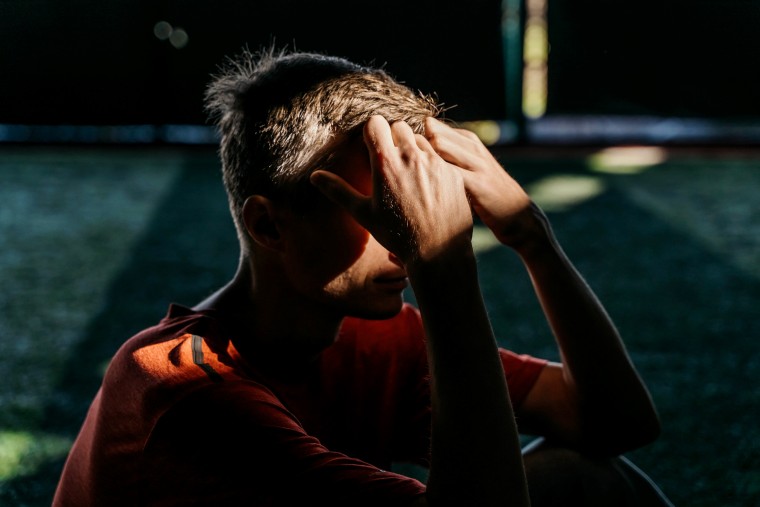Two severe types of headaches are strongly linked to the body’s internal clock, a meta-analysis published Wednesday found.
Cluster headaches are a rare type of headache that cause bursts of intense pain around the eye. Each burst lasts about 15 minutes, but an attack can last between one and three hours. The condition is more common in males than in females. The opposite is true for migraines, a severe headache condition that is three times more prevalent in females than in males.
And while cluster headaches commonly occur during the night, migraines usually come on during the day, the meta-analysis found.
“Cluster headache is known to be circadian, but it was surprising how circadian migraine is,” said Dr. Mark Burish, the study’s lead author and the director of the Will Erwin Headache Research Center at UTHealth Houston.
The meta-analysis included 72 studies on how circadian rhythm —the body’s internal clock — appears to be involved in either headache disorder, which together impact more than 40 million people in the U.S.
The studies included data on the time of day or time of year a person got a headache, and whether or not the headaches came on just before, during, or just after sleep. Some of the studies also included research on whether certain genes associated with circadian rhythm are more common in people who got these types of headaches. One study was a genetic analysis conducted in nonhuman primates, but the rest were based on humans.
The results were published Wednesday in Neurology, the American Academy of Neurology’s medical journal.
Cluster headaches were closely tied to circadian cycles, especially during season changes in the spring and fall, the researchers found. More than 70% of people included in 16 studies on cluster headaches reported more attacks during these seasons and said they usually occurred between the late hours of the night and early hours of the morning.
When it came to genetic predisposition, the studies showed that five of the nine genes associated with cluster headaches were also involved in regulating circadian rhythms.
What came as a surprise to the researchers was that half of migraine headaches across eight studies were associated with clear ebbs and flows throughout the day as well as the year. Most people had migraines during the morning, day or evening, and there was a stark drop off in the headaches from 11 p.m. to 7 a.m. They also reported more or worse migraines between April and October.
Many genes are associated with risk for migraine, and the study found 110 of these genes were also tied to circadian rhythm.
Burish said that understanding the link between circadian rhythm and these headache disorders could lead to better treatments.
“Medications that target the circadian cycle might be a new type of treatment we can offer these patients,” he said, adding that the findings on migraines are particularly interesting.
“We weren’t sure if looking at circadian targets of therapy for migraine would actually do anything but after putting all of this together, we are more confident that it could be,” he said.
The hormone link
In addition to circadian rhythm, the meta-analysis also zeroed-in on two hormones: cortisol and melatonin.
“Circadian rhythms are driven by hormones,” said Dr. Narayan Kissoon, a neurologist at the Mayo Clinic in Rochester, Minnesota, who specializes in headache medicine and who was not involved in the new research.
The hypothalamus — the area of the brain that primarily controls the biological clock — is linked to the glands that produce melatonin, which signals it’s time to sleep, and cortisol, the body’s cue that it should be awake.
The meta-analysis found that people who get migraines often produce less melatonin than people who don’t get these headaches, and produce even less during an attack. People with cluster headaches had both higher cortisol levels and lower melatonin levels.
Sleep deprivation causes a spike in cortisol levels, Burish said, though he noted that the link between melatonin levels and headache disorders appears to be much clearer than the potential association with cortisol.
“Not only are these headache disorders influenced by sleep, conversely they are also huge disruptors of sleep. They might feed back and amplify whatever the circadian mechanisms are,” said Dr. Andrew Charles, director of the UCLA Goldberg Migraine Program, who was not involved in the new study. “It’s hard to know if the influence of the cortisol is related to the circadian rhythms or something related to the stress response.”
While circadian cycles are clearly tied to cluster headaches, migraines are a much more complicated condition to classify, said Kissoon, of the Mayo Clinic.
“There are so many factors that play into migraine, but one thing we often find is things that cause changes in homeostasis have a major impact on risk for migraine,” he added, referring to the state of balance within the body. This includes stress, which causes cortisol levels to spike.
Smoking, diet, genetics unrelated to circadian rhythm, and how much a person exercises are also factors that can influence migraines, but the new research provides an important clue that could lead to better treatments for some people, experts said.
“Circadian rhythms and their impact on migraine are often overlooked,” Kissoon said. “While migraine is a complex disorder, this is one piece of the puzzle that would benefit from further exploration into the ways we can better treat both migraine and cluster headache.”
Follow NBC HEALTH on Twitter & Facebook.
